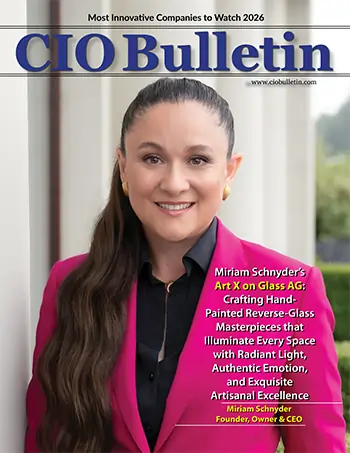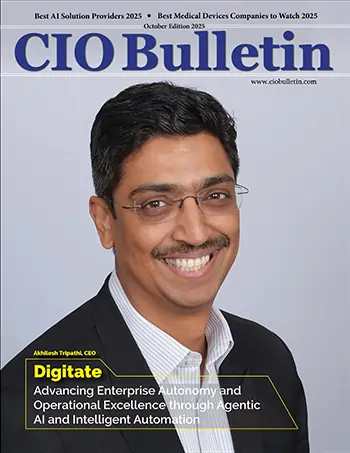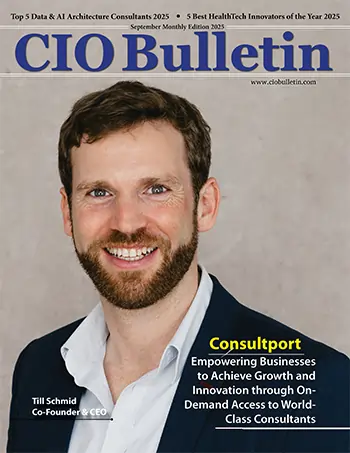50 Most Admired Companies to Watch 2024
CIO Bulletin

Imagine a world where technology isn't just a tool but a partner in driving progress and making life better. This is the vision SAP has pursued since its inception in 1972. From its modest beginnings in Walldorf, Germany, SAP has grown into a global titan, employing over 105,000 people across 157 countries. With a network of over 24,000 partners and 100 development locations worldwide, SAP has become synonymous with innovation in enterprise technology.
But SAP isn't just about numbers and tech jargon. It's about creating real-world impact through design, ethics, and sustainability. At the heart of this transformation is Arin Bhowmick, SAP’s Chief Design Officer. Under his leadership, SAP is redefining what it means to create user-centered, impactful technology.
We at CIO Bulletin had the great opportunity to interview Arin Bhowmick and explore how SAP’s approach to design is reshaping the future of business and technology. In this exclusive interview, Mr. Bhowmick shared deep insights into SAP’s journey, its commitment to ethical AI, and how the company is leading the charge toward a more sustainable and design-driven future.
Interview Highlights
Q. SAP has been at the forefront of enterprise application software, redefining ERP and creating networks of intelligent enterprises. Could you share some insights into SAP's journey and how it has evolved to become a market leader in providing transparency, resiliency, and sustainability across global supply chains?
Founded in 1972, SAP is a multinational software company headquartered in Walldorf, Germany. As the market leader in enterprise application software, SAP helps companies of all sizes and in all industries run better by redefining ERP and creating networks of intelligent enterprises that provide transparency, resiliency, and sustainability across supply chains. SAP’s end-to-end suite of applications and services enables its customers to operate profitably, adapt continuously, and make a difference worldwide.
When it comes to its product portfolio, SAP has built up dominance as an undisputed and consistent leader across segments with a sustained focus on product and customer-driven innovations. SAP Ariba was rated as the market share leader in the procurement application space as published in the IDC Worldwide Procurement Applications Market Shares report. SAP Concur was named a top-rated expense management software by TrustRadius based on user feedback. IDC also named SAP SuccessFactors as a leader in the MarketScape for Worldwide Modern Talent Acquisition. SAP S/4HANA Cloud was named a leader in the Gartner® Magic Quadrant™ for Cloud ERP for Service-Centric Enterprises. It was also named a leader in the new IDC MarketScape for U.S. BI and Analytics platforms, as well as a leader in the 2022 Gartner Magic Quadrant for Digital Commerce for the eighth consecutive year—the only vendor to remain in the leader's quadrant for the entire lifespan of this Magic Quadrant.
Q. Most people equate design to being about the look and feel of a product. How do you view design? Why is design important for business and enterprise software?
My operative definition of design is that design is an expression of intent—to solve a problem and generate a positive outcome. It’s a human-centered innovation framework. Design is part of the DNA of the systems, processes, and products that drive innovations and experiences. It is not just about the UI or just how it looks or functions, but rather the forces, framework, disciplines, and execution that drive experience excellence in each touchpoint of the customer journey.
Experience is a sum of many parts, and in the modern cloud world, it is a composite of user interactions all the way across the customer end-to-end journey—from product and solution discovery, explorations, trial experiences, first use and productive use, and the enter lifecycle of managing and extending usage and adoption.
Design has the potential to impact all business metrics. Whether it’s customer growth, customer satisfaction, customer retention, product usage and adoption, customer renewals, or brand loyalty, design and user experience can have a significant impact on all these metrics. That’s true across any industry, as several studies have already shown that design-driven companies outperform the market in multiples.
As I reflect on SAP’s mission to improve people’s lives and on our business priorities to be the leader in enterprise software and business AI, design has a tremendous opportunity to shape and influence the path forward. Given that more than 90% of the world’s top businesses and mission-critical transactions run on SAP systems, we can make a huge difference in our users' lives if we are able to build experiences that match their mental models, leverage and embed technological advancements into their systems of use, and build in ethical intelligence to extend human potential and satisfaction.
Q. What is the role of design at SAP? How does that shape your strategy and goals as the Chief Design Officer?
Design and User Experience are company-wide strategic priorities at SAP. In today's fast-paced and highly competitive business landscape, companies across industries are increasingly recognizing the significance of design in their products and services. SAP, a global leader in enterprise software solutions, is no exception. With its extensive range of enterprise applications and services, SAP understands the critical role that design plays in delivering exceptional user experiences to help achieve business success in terms of customer satisfaction, top-line and bottom-line growth, market and audience expansion, and enhanced product usage and adoption.
Design, in the context of SAP, goes beyond mere aesthetics. It encompasses the entire user experience, across all touchpoints via digital funnels and journeys into productive use. As the Chief Design Officer, it is my responsibility to ensure that design excellence and human-centered outcomes are the cornerstone of how we work and the solutions we deliver to our customers and users. Our UX strategy is aligned with the company vision of improving people’s lives and the corporate strategy to be the sustained leader in business applications and AI. In addition to great technology and functionality, we want SAP to be known for differentiated and purposeful user experiences. Our goals for SAP Design are to build inclusive products that people love, excite our customers, partners, and the industry with meaningfully crafted and design-led innovations that matter, and scale the business impact of design for our company and its customers. These goals help define our baseline and how we measure different aspects of the user experience to ensure that we’re continuously evolving.
Q. SAP has a huge ecosystem and install base. How do you design for scale?
SAP is the leading worldwide vendor of business and enterprise applications. It has products and solutions across a multitude of business domains and industries, some built organically and some extended through acquisitions. To ensure that our product portfolio can scale with consistent, cohesive, and integrated experiences, we rely heavily on the SAP Design System.
The SAP Design System includes:
The SAP Design System is continuously evolving to meet our users' needs. It's built on insights from our customers to unite SAP's extensive portfolio of software and applications with one exceptional digital experience. By utilizing the SAP Design System, SAP and its ecosystem of partners provide scalable, consistent, and modern solutions across the portfolio. Customers notice increased productivity among their users, accelerating their business, and the ROI leads to renewals and investments in new SAP applications.
Q. Sustainability has become a key focus for businesses globally. How does SAP incorporate sustainability management into its solutions, and what role does it envision for technology in creating a more sustainable future for organizations and society as a whole?
In line with our purpose, our objective is to create a positive economic, environmental, and social impact worldwide, with a special focus on climate action, the circular economy, social responsibility, and holistic steering and reporting. SAP aspires to a world with zero emissions, zero waste, and zero inequality. We are committed to achieving net zero along our value chain in line with a 1.5°C future by 2030, 20 years earlier than originally targeted. We cooperate with international and local e-waste disposal partners to refurbish and recycle our electrical and electronic waste, including data center servers, PCs, peripherals, and mobile devices. Through this collaboration, we monitor and report the end-of-life treatment applied to our disposed IT assets and devices. Although our operations are not water-intensive, SAP continues to use water as efficiently as possible in our data centers and offices. For example, at our headquarters' data centers, we use adiabatic cooling (evaporative cooling) as well as a closed water circuit to minimize water consumption for cooling our server racks.
We are also focused on creating a diverse and inclusive culture, which makes us a better company by fueling our innovation, enhancing our work experience, and enabling our success in a changing world. This commitment is reflected in our belief in ethical design through our design system and inclusive, accessible frameworks and practices.
SAP has top scores in the Dow Jones Sustainability Indices (DJSI) and Carbon Disclosure Project, as well as a Terra Carta Seal. We are also committed to the United Nations Sustainable Development Goals, being transparent in ESG reporting, energy and environmental management, and social responsibility. In addition to pursuing our own targets, we are encouraging customers to become more sustainable at scale with a portfolio of groundbreaking sustainability solutions such as SAP Sustainability Control Tower, SAP Responsible Design and Production, SAP Sustainability Footprint Management, and more.
Q. SAP provides global solutions for a wide range of users. How do you ensure inclusivity?
Referred to by many names—inclusive design, design for all, universal experiences—the inclination to create experiences that meet the needs of all people has been a topic in the software industry for decades. For SAP, it represents a key pillar of our design strategy. We're committed to making SAP’s products more accessible to everyone, especially people with disabilities. This commitment is driven by our work in the W3C Web Content Accessibility Guidelines and ARIA working groups, and best practices from inclusive design to test automation. SAP is making inclusive design a priority in our UX transformation, but what does that look like beyond fulfilling technical requirements?
Q. What is SAP’s viewpoint on AI?
Artificial Intelligence, and especially generative AI, marks a paradigm shift in how computer systems learn from data, solve complex problems, and even provide creativity when needed. We believe this paradigm shift will fundamentally change work, business, and society. SAP is committed to helping organizations through this transformative moment by creating business outcomes that were previously unimaginable through SAP Business AI. The SAP Business AI approach focuses on delivering relevant, reliable, and responsible AI capabilities deeply integrated across key business functions and technology platforms, enabled by partnerships with leading AI ecosystem players. At SAP, we care deeply about the impact of AI on the well-being of people, the health of our customers’ businesses, and society and economies. Our development of artificial intelligence software is guided by a strong commitment to ethics, human rights, and the responsible use of technology.
Q. Do you have a specific point of view or principles for designing for AI?
We believe AI has immense potential to benefit humanity, but the user experience must be designed thoughtfully with clear and intentional design principles. We believe in the following:
Arin Bhowmick, Chief Design Officer
– Arin Bhowmick, Chief Design Officer







